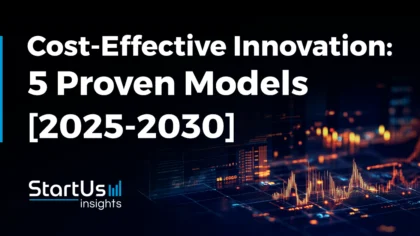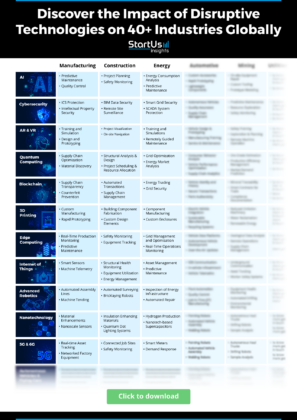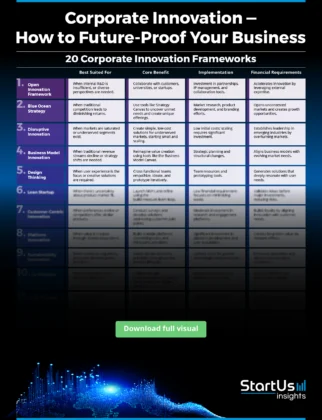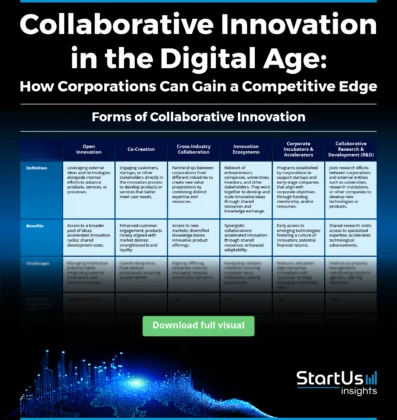Accelerate Productivity in 2025
Reignite Growth Despite the Global Slowdown
Technology intelligence, or tech intelligence, is a strategic process of gathering, analyzing, and interpreting information about emerging trends, technologies, and innovations. By leveraging it, companies can anticipate changes, identify opportunities, and mitigate risks.
Some of the key activities include monitoring startup activity, patents, industry reports, and competitor strategies. Moreover, its ability to forecast trends and map innovation landscapes drives actionable insights that assist in strategic decision-making, such as optimizing R&D investments.
The global adoption of artificial intelligence as a tool for technology intelligence is increasing, but it varies significantly. In India, the artificial intelligence adoption rate is 59%, whereas in Australia, Spain, and France, it stands at 29%, 28%, and 26%, respectively.
Industry-wise, the highest adoption rate of AI is observed in the information technology sector at 18.1%, while the construction and agriculture industries show the lowest adoption rate, standing at around 1.4%. A major factor influencing the adoption of technology intelligence is the size of the organization, with larger enterprises demonstrating higher adoption rates as financial constraints are less significant for them.
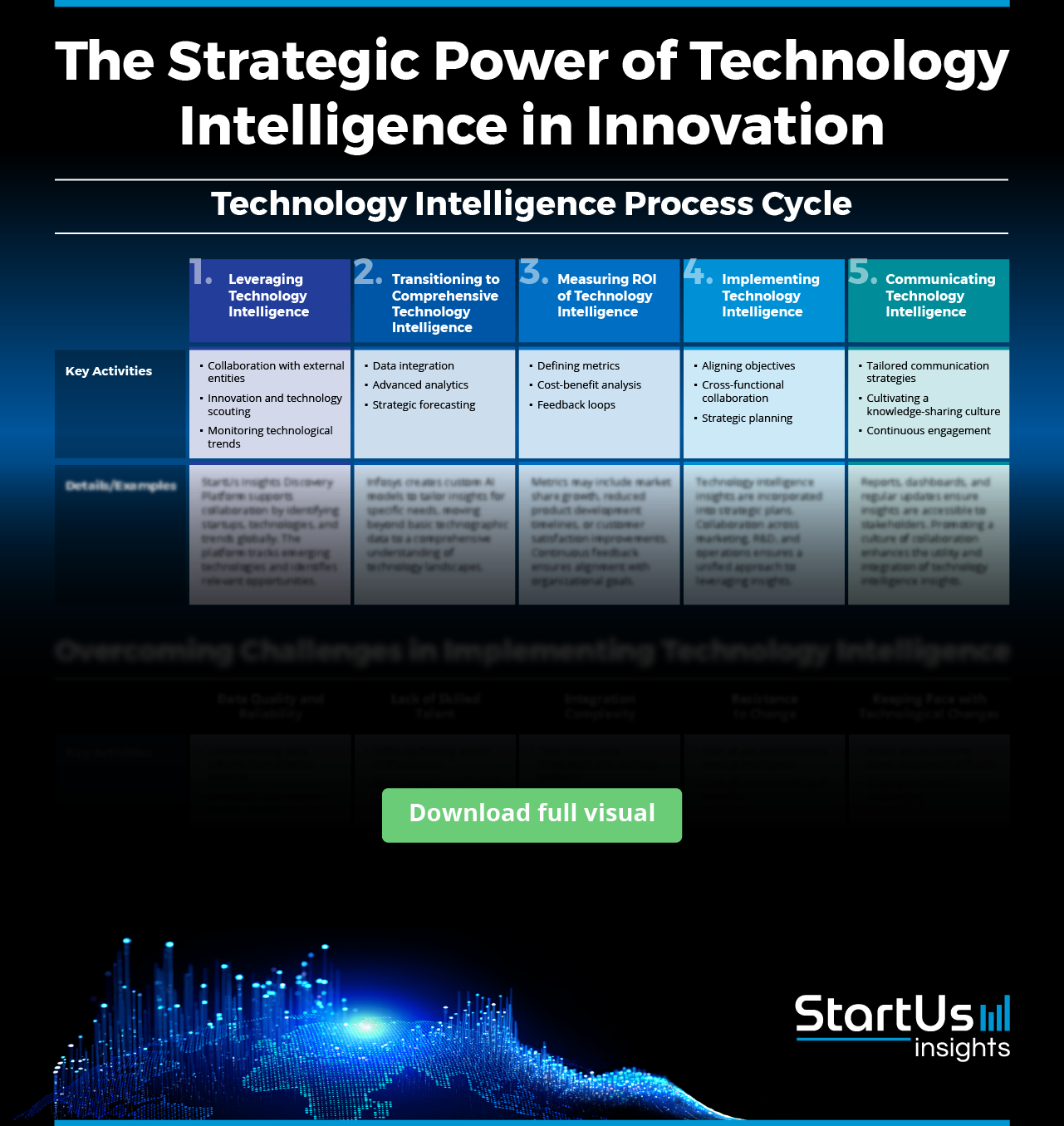
What you can expect from this report:
- 5 Benefits of Technology Intelligence
- Building an Effective Technology Intelligence Framework
- Key Intelligence Topics (KIT)
- Tools and Technologies in Technology Intelligence
- Intelligence Process Cycle
- Challenges in Implementing Technology Intelligence
- The Future of Technology Intelligence
- Strategic Imperative of Technology Intelligence: Act Now
Key Takeaways
- 5 Benefits of Technology Intelligence: Technology intelligence drives informed decision-making, fosters innovation and ensures competitive advantage.
- Building an Effective Technology Intelligence Framework: A structured three-level model (Framework, System, Process) is essential for acquiring and utilizing tech intelligence effectively.
- Key Intelligence Topics (KIT): Strategic decisions, early signals, and monitoring key players are critical focus areas for directing TI efforts.
- Tools and Technologies in Technology Intelligence: Advanced platforms like StartUs Insights streamline data analysis, collaboration, and forecasting for actionable insights.
- Intelligence Process Cycle: A systematic cycle of leveraging external knowledge, integrating data, measuring ROI, and aligning TI with business strategy.
- Challenges in Implementing Technology Intelligence: Common barriers include data quality, skill gaps, and resistance to change, which can be mitigated with AI tools and expert platforms.
- The Future of Technology Intelligence: Emerging trends like AI, quantum computing, and low-code platforms will redefine the scope and efficiency of TI processes.
- Strategic Imperative of Technology Intelligence: Act Now: Adopting TI frameworks promptly is crucial for companies to innovate, anticipate disruptions, and secure market leadership.
In recent years, leading firms like Microsoft, Google, Amazon, and Nvidia have embraced technology intelligence for transformative growth by embedding AI across their products, services, and strategies. Despite challenges such as high costs, data management complexities, and talent shortages, technology intelligence drives innovation by enabling informed decisions and identifying competitive differentiators.
In essence, technology intelligence is a powerful enabler of corporate innovation. By equipping corporations with actionable insights, it bridges the gap between emerging trends and long-term strategies. In this in-depth report, we will explore technology intelligence comprehensively and dive into its crucial role in innovation.
5 Benefits of Technology Intelligence
Let’s explore some of the benefits of technology intelligence and how it enabled companies across the globe to stay competitive in changing markets:
1. Informed Decision-Making
Technology intelligence promotes data-driven decision-making by providing comprehensive insights into emerging technologies, market trends, and potential disruptions. For example, artificial intelligence and advanced analytics can process vast amounts of data from diverse sources, such as the www, patent filings, and scientific journals, at a much faster rate.
Pfizer leveraged real-time data analytics and monitored global research trends through technology intelligence, enabling informed decisions that accelerated clinical trials and regulatory approvals.
2. Competitive Advantage and Leadership
Technology intelligence supports corporations in gaining a significant edge over competitors by identifying breakthrough technologies and high-potential inventions early. It also helps in understanding the value and potential impact of emerging technologies ahead of the competition.
Tesla, for instance, has maintained its leading position in the electric vehicle market by continuously integrating advanced technologies, such as battery systems and autonomous driving capabilities, with the help of technology intelligence.
3. Innovation Catalyst
Corporations employ technology intelligence to identify new market opportunities and unexplored technological avenues. It facilitates strategic partnerships and collaborations with relevant entities for next-generation innovation. Technology intelligence also enhances internal R&D processes through advanced simulation tools and rapid prototyping techniques.
For example, Apple’s development of the M1 chip was driven by insights into semiconductor advancements, enabling the company to innovate its product line with improved performance and energy efficiency.
4. Enhanced Market Understanding
Technology intelligence provides a deeper understanding of the market by analyzing competitors’ activities and R&D strategies. Insights into customer behavior, preferences, and emerging needs additionally support customization to elevate the customer experience.
Netflix, for instance, employs technology intelligence to analyze viewing patterns and content trends, enabling the company to maintain a competitive edge in the streaming industry.
5. Risk Mitigation
Technology intelligence assesses potential risks associated with new technologies and developments, enabling corporations to implement robust mitigation strategies.
For example, Microsoft uses technology intelligence to monitor cybersecurity threats, allowing it to take proactive measures to protect its systems and customer data.
Building an Effective Technology Intelligence Framework
Begin with the Three Level Model
The three-level model for technology intelligence is created to structure the acquisition of technology intelligence. The model was validated through case studies involving 14 technology-based companies. The three levels involve:
- Framework
- System
- Process
1. Framework: Establishing Strategic Context
The framework level defines the overarching structure and guidelines for technology intelligence activities that align them with an organization’s strategic goals. It answers critical questions on which technological domains a company should monitor, what objectives drive its efforts, or even, how does a technology fit within broader business strategies?
Core Features:
- Strategic Alignment: Ensures that the technology intelligence efforts focus on technologies and trends critical to the company’s competitive positioning.
- Defined Scope: Identifies priority areas, such as emerging markets, disruptive technologies, or regulatory landscapes.
Integration into Decision-Making: Embeds technology intelligence insights into strategic planning, R&D roadmaps, and market-entry strategies.
Take Siemens, a leader in industrial automation and electrification, for example. The company employs a technology intelligence framework to focus on Industry 4.0 technologies like IoT, AI, and robotics. By embedding it into its strategic planning, Siemens identified opportunities to innovate in predictive maintenance systems and digital twin technologies and align with customer needs in smart manufacturing.
2. System: Building the Infrastructure
The system level encompasses the tools, technologies, and infrastructure required to support technology intelligence. It involves databases, software platforms, analytics tools, and collaboration systems to facilitate the efficient collection, storage, and analysis of technological information.
Core Features:
- Robust Databases: Centralized repositories for patents, academic research, market trends, and competitor innovations.
- Analytical Tools: Platforms like StartUs Insights Discovery Platform for trend forecasting, and scenario modeling.
- Collaboration Systems: Tools enabling cross-functional teams to share and act on insights.
Intel leverages advanced analytics platforms to mine patent data and monitor competitor innovations. Its technology intelligence system integrates AI-driven tools like natural language processing (NLP) to analyze technical literature. This also enabled the rapid identification of disruptive technologies in semiconductor manufacturing.
3. Process: Executing Methodologies
The process level involves the step-by-step methodologies used to acquire, analyze, and disseminate insights. It includes information gathering, data analysis, and communication of actionable intelligence to decision-makers.
Core Features:
- Information Gathering: Systematic scanning of sources, such as industry reports, technical papers, and patent filings.
- Data Analysis: Using techniques like trend analysis, benchmarking, and SWOT assessments to extract actionable insights.
- Dissemination of Insights: Tailoring reports, dashboards, and presentations to different stakeholders, ensuring accessibility and relevance.
Toyota employs a structured tech intelligence process to support its innovation in hydrogen fuel cell technology. The process begins with identifying breakthroughs in material science (gathering), followed by analyzing market adoption barriers and regulatory developments (analysis). Finally, insights are shared across R&D and marketing teams (dissemination), aligning product development with global energy trends.
The Key Intelligence Topics (KIT)
KITs are focal areas that direct technology intelligence efforts toward the most critical aspects of an organization’s success. They ensure that intelligence activities are aligned with strategic objectives and operational needs.
1. Strategic Decisions
- R&D Policies: Technology intelligence provides insights into emerging technologies and scientific advancements, guiding research focus areas and resource allocation. For instance, StartUs Insights’ Technology Scouting service enables organizations to discover emerging technologies and scientific advancements, guiding research focus areas and resource allocation.
- Investment Decisions: By analyzing technological trends and market dynamics, tech intelligence informs investment strategies, such as entering new markets or acquiring innovative startups. For example, a technology scouting platform provides insights into technological trends and market dynamics that inform investment strategies like entering new markets or acquiring innovative startups.
- Business Plans: Employing platforms that offer trend intelligence and integrating those insights into business strategy ensures that technological developments are considered in long-term planning. This enables corporates to anticipate market shifts and customer demands.
2. Early Signals
- Market Trends: By staying informed about market trends, corporates maintain relevance and competitiveness. Consider employing a platform that offers trend intelligence to monitor changes in consumer behavior, industry standards, and economic indicators allowing organizations to adapt products and services proactively.
- Emerging Technologies: Identifying nascent technologies enables companies to innovate and stay ahead of potential disruptions. For instance, early awareness of artificial intelligence applications can lead to first-mover advantages.
- Legislative Changes: Staying informed about regulatory developments aids in compliance and in leveraging new policies for strategic benefit.
3. Monitoring Key Players
- Competitors: Analyzing competitors’ technological advancements, patent filings, and strategic initiatives provides insights into market positioning and potential threats.
- Partners: Assessing the technological capabilities of current and potential partners facilitates effective collaborations and innovation synergies.
- Regulators: Understanding the focus areas of regulatory bodies aids in aligning technological developments with compliance requirements.
Tools and Technologies used in Trend Intelligence
Implementing an effective technology intelligence framework necessitates the use of various tools and technologies to efficiently gather, analyze, and disseminate information.
- Advanced Analytics Platforms: Utilizing AI and machine learning algorithms, these platforms process extensive datasets to uncover patterns and predict trends, enhancing decision-making capabilities.
- Patent Analysis Software: Tools such as the Discovery Platform and Innography enable monitoring of patent landscapes, assisting in identifying technological trends and potential areas for innovation.
- Collaboration Platforms: Collaboration platforms ensure seamless knowledge sharing and integration of tech intelligence activities across the organization. Lucid provides visual collaboration tools that integrate artificial intelligence to enhance team productivity. These tools support various stages of work, from ideation to execution, by offering features such as real-time co-authoring, diagramming, and whiteboarding.
- Web Scraping Tools: These tools automate data collection from online sources, including competitor websites and industry forums, providing real-time intelligence.
- Visualization Software: Applications like Tableau and Power BI create interactive dashboards, facilitating the interpretation and communication of TI insights across the organization.
- Natural Language Processing (NLP) Tools: NLP technologies analyze unstructured data from sources like scientific literature and social media, extracting relevant information for trend intelligence purposes.
- Competitive Intelligence Platforms: Comprehensive solutions such as Klue, Contify, and Crayon curate information and strategic insights, supporting informed decision-making.
- Social Media Monitoring Tools: Platforms like RivalIQ analyze competitors’ social media strategies and engagement, providing insights into market sentiment and brand positioning.
- Technology Forecasting Software: Anticipate future technological developments by leveraging Trend Intelligence services. This data-driven methodology will forecast technology trends and market disruptions.
- CRM Integration: Tools like integrating with Customer Relationship Management systems, delivering real-time intelligence on prospects and competitors, and enhancing customer engagement strategies.
Intelligence Process Cycle: A Systematic Approach

It is a systematic methodology that gathers, analyzes, and disseminates raw data into actionable insights and guides strategic decision-making within organizations. The cycle consists of several stages. Here’s a detailed exploration of each stage particularly in the context of tech intelligence:
Stage 1: Leveraging Technology Intelligence
In this initial stage, corporates utilize tech intelligence to drive corporate innovation by systematically identifying and integrating external knowledge and resources. Key activities include:
- Collaboration with External Entities: Corporations leverage tech intelligence to engage with startups, research institutions, and other external partners, sharing knowledge and resources. This collaboration fosters innovative solutions that might not have been developed internally. For instance, the StartUs Insights Discovery Platform supports collaboration by identifying emerging startups and trends globally, enabling companies to find relevant partners or solutions that align with their strategic objectives.
- Technology Scouting & Trend Monitoring: Tools like Trend Intelligence and Technology Scouting facilitate the identification of advanced technologies and innovations. These tools allow organizations to scout potential opportunities across industries, monitor innovation, and evaluate the readiness and impact of emerging technologies.
In this phase, corporates focus on keeping an open mindset towards innovation, where external insights significantly contribute to internal capabilities.
Stage 2: Transitioning from Technographics to Comprehensive Technology Intelligence
This stage focuses on evolving from basic technographic data, which includes information about technology usage within organizations, to a more comprehensive understanding of technology landscapes. Some of the key components include:
- Data Integration: Organizations integrate diverse data sources, such as industry and market research, competitor analysis, and user feedback, to create a holistic view of the technology environment.
- Advanced Analytics: Leveraging AI and machine learning tools enhance the analysis of collected data, providing deeper insights into technology trends and user behaviors.
- Strategic Forecasting: Predictive analytics enables companies to anticipate future technological developments and assess their potential impact on business strategies.
Transitioning to comprehensive technology intelligence equips organizations to make more informed strategic decisions based on a broader understanding of their technological ecosystem. For example, Infosys exemplifies this approach by assisting clients in developing custom AI models tailored to specific data and operational needs. This approach goes beyond generic technology adoption, streamlining operations, and boosting productivity.
Stage 3: Measuring the ROI of Technology Intelligence
In this stage, organizations assess the effectiveness of their technology intelligence initiatives by measuring return on investment (ROI). This involves:
- Defining Metrics: Establishing clear metrics for success is crucial. These may include increased market share, improved product development timelines, or enhanced customer satisfaction.
- Cost-Benefit Analysis: Corporations measure the effectiveness of technology intelligence by conducting cost comparisons and analysis associated with its activities against the tangible benefits gained from improved decision-making and innovation.
- Feedback Loops: Continuous feedback mechanisms refine processes and ensure that technology intelligence efforts align with organizational goals.
Measuring ROI allows organizations to justify investments in technology intelligence and optimize their strategies for maximum impact.
Stage 4: Implementing Tech Intelligence in Business Strategy
This stage emphasizes integrating technology intelligence into overall business strategies. Organizations that consider themselves technology-driven are better positioned to leverage advancements in AI and other technologies, fostering a culture of continuous innovation. Key actions include:
- Aligning Objectives: Ensuring that technology intelligence initiatives align with broader business goals to achieve desired outcomes.
- Cross-Functional Collaboration: Involving departments such as marketing, R&D, and operations fosters a unified approach to leveraging technology intelligence insights across the organization.
- Strategic Planning: Incorporating technology intelligence insights into strategic planning processes enables organizations to adapt swiftly to market or technological changes.
Successful implementation ensures that technology intelligence becomes a core component of strategic decision-making rather than an isolated function.
Stage 5: Communicating Technology Intelligence
The final stage focuses on effectively disseminating insights derived from technology intelligence throughout the organization. This is critical for aligning strategies and ensuring insights are actionable. Key strategies include:
- Tailored Communication Strategies: Different stakeholders require different types of information. Communication should be customized — whether through reports, presentations, or dashboards — to ensure accessibility and relevance.
- Cultivating a Knowledge-Sharing Culture: Encouraging a culture that values knowledge-sharing enhances collaboration and ensures valuable insights are disseminated effectively across teams.
- Continuous Engagement: Regular updates and discussions on technology intelligence findings keep teams informed and engaged with ongoing developments in the technological landscape.
Effective communication ensures that insights lead to informed decision-making at all levels of the organization, fostering alignment and driving innovation.
Challenges in Implementing Technology Intelligence
Implementing Technology Intelligence comes with several challenges. Below are seven key challenges and their corresponding solutions:
1. Data Quality and Reliability
Challenge:
Organizations often face an overwhelming volume of data from diverse sources, making it difficult to extract relevant insights. While data overload is addressed, the quality and reliability of data sources is also a significant issue.
Solution:
Implement advanced data analytics tools such as AI-driven algorithms and machine learning to process large datasets efficiently. Utilizing platforms like Tableau or Power BI can help visualize data, enabling stakeholders to focus on actionable insights. Moreover, for verifying information from multiple sources, implement data governance frameworks and quality assurance processes.
2. Lack of Skilled Talent
Challenge:
The implementation of technology intelligence requires skilled professionals who can analyze data, manage tools, and interpret insights. Many organizations struggle to find or retain such talent.
Solution:
Organizations can partner with specialized providers or utilize dedicated platforms, like the StartUs Insights Discovery Platform, to eliminate the need for extensive in-house expertise and save time. This AI-powered innovation intelligence platform offers access to over 4.7 million startups and scaleups globally, along with data on more than 20,000 emerging technologies and trends.
3. Integration Complexity
Challenge:
Integrating technology intelligence into existing systems and workflows can be technically challenging and time-consuming.
Solution:
Adopt modular and API-driven solutions that allow seamless integration with existing systems. Partnering with experienced technology providers and conducting phased implementation can also reduce integration challenges.
4. Resistance to Change
Challenge:
Employees and stakeholders may resist adopting technology intelligence due to fear of job displacement or lack of understanding of its benefits.
Solution:
Foster a culture of change by conducting awareness campaigns that highlight the benefits of technology intelligence for both employees and the organization. Engage employees through hands-on training sessions and involve them in the implementation process to build trust.
5. Keeping Pace with Rapid Technological Changes
Challenge:
The pace of technological advancement is accelerating, making it challenging for organizations to stay updated and adapt quickly.
Solution:
Establish real-time monitoring systems using platforms like the StartUs Insights Discovery Platform to track emerging technologies and market dynamics continuously. Engage in open innovation and build partnerships with startups and research institutions to stay ahead of technological trends.
6. Data Privacy and Security Concerns
Challenge:
With the increasing reliance on data, organizations face challenges in ensuring the privacy and security of sensitive information.
Solution:
Adopt robust cybersecurity measures, including encryption, multi-factor authentication, and compliance with data protection regulations such as GDPR. Regularly conduct security audits and train employees on best practices for data handling.
7. Measuring ROI Effectively
Challenge:
Organizations often struggle to quantify the return on investment (ROI) from technology intelligence initiatives, making it difficult to justify ongoing expenses.
Solution:
Define clear KPIs aligned with business objectives, such as reduced time-to-market, cost savings, or revenue growth. Use performance dashboards to track and communicate the tangible benefits of technology intelligence in real time.
The Future of Technology Intelligence
The future lies at the confluence of advanced technologies and evolving organizational strategies. As complex challenges grapple the organization, technology intelligence will be the cornerstone of agile, data-driven decision-making. Here’s a glimpse of the key trends shaping the future of Technology Intelligence:
1. Artificial Intelligence and Machine Learning: Precision at Scale
AI and machine learning will transform how firms process, evaluate, and act on innovation-related data. Advanced analytics enabled by these technologies will sift through massive datasets from various sources, finding trends, risks, and opportunities with unprecedented speed and precision. AI algorithms will spot patterns and anomalies and machine learning models are going to evolve to provide increasingly sophisticated insights, making predictive analytics an essential part of innovation strategy.
2. Generative AI: Revolutionizing Creativity and Strategy
Generative AI stands poised to redefine technology intelligence methodologies, It allows businesses to create domain-specific insights with minimal human intervention. It is anticipated that a majority of businesses will adopt generative AI tools, such as Retrieval-Augmented Generation (RAG), to increase decision-making efficacy by 50%. Beyond analytics, these technologies will speed up content creation, product design, and collaborative ideation to support innovation across multiple industries.
3. Ethical and Trustworthy AI: Building Responsible Intelligence
As AI becomes integral to technology intelligence, the focus on ethical implementation will expand. AI TRiSM (Trust, Risk, and Security Management) frameworks will ensure that the insights generated are not only accurate but also consistent and ethical. Organizations will prioritize openness and implement controls to ensure the stability and security of AI-powered innovation processes.
4. Quantum Computing: A New Paradigm in Strategic Intelligence
Quantum computing will enable previously imagined possibilities. With its tremendous processing capability, quantum technology will improve simulations, correlations, and predictive modeling. This achievement will have a particularly significant influence on domains that need high-stakes decision-making, such as emissions intelligence and advanced materials design, pushing strategic innovation planning to new heights.
5. Democratization through Low-Code/No-Code Platforms
Low-code and no-code technologies will democratize the development of tech intelligence tools, enabling teams without technical expertise to create and customize solutions. Nearly 70% of new enterprise applications are expected to leverage these platforms, fostering faster adaptation to evolving innovation demands and reducing development cycles significantly.
6. Cross-functional Synergy: Breaking Down Silos
Future tech intelligence frameworks will thrive on seamless integration and collaboration. Sophisticated APIs and microservices will connect technology scouting tools across departments, ensuring insights are shared effortlessly. Enhanced collaborative technologies will break down silos, promoting cross-functional innovation and ensuring that all business units align toward common goals.
7. Security and Surveillance: Strengthening the Core
As technology intelligence tools become more useful, their importance in security will grow. AI-enhanced surveillance systems will incorporate biometric verification, automated picture processing, and human pose estimation to improve both safety and operational efficiency. These capabilities will benefit both the public and private sectors by guaranteeing effective risk reduction and compliance in a continually changing environment.
The Strategic Imperative of Technology Intelligence: Act Now
In today’s intensely competitive market, the question for corporations is no longer whether to adopt tech intelligence but when and how swiftly to do so. Leading organizations like Microsoft, Tesla, and Pfizer are already reaping the benefits of integrating technology intelligence into their strategic core, leveraging its power to drive innovation, mitigate risks, and secure market leadership.
Corporations that delay adopting a robust tech intelligence framework risk falling behind in their industries, unable to foresee disruptions or capitalize on emerging opportunities. The future belongs to agile, forward-thinking companies that embrace data-driven strategies, integrate advanced tools, and foster a culture of continuous learning and innovation.
Therefore, by implementing platforms like StartUs Insights Discovery Platform, companies can uncover actionable insights, drive collaboration across teams, and forecast trends with precision, turning challenges into opportunities.
The path to innovation leadership starts here. Begin by building a robust technology intelligence framework, invest in cutting-edge tools, and transform insights into impact. Act now — because in the race for innovation, hesitation can cost you the future.

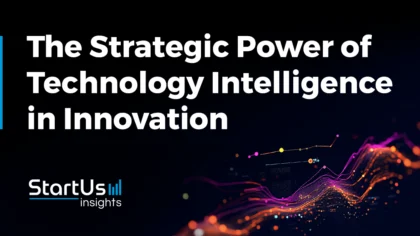

![Business Resilience Planning: 10 Strategies & Technologies to Tackle the Current Market [2025-2026]](https://www.startus-insights.com/wp-content/uploads/2025/06/Business-Resilience-Planning-SharedImg-StartUs-Insights-noresize-420x236.webp)
![10 Biggest Business Trends: What to Invest in, Build, and Watch Closely [2025-2030]](https://www.startus-insights.com/wp-content/uploads/2025/06/Business-Trends-SharedImg-StartUs-Insights-noresize-420x236.webp)
